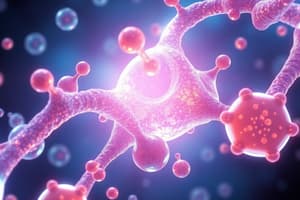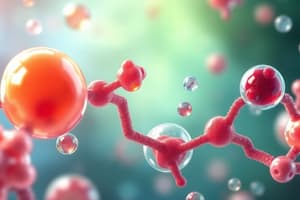Podcast
Questions and Answers
What are the two primary possibilities that can occur with biochemical substances in humans?
What are the two primary possibilities that can occur with biochemical substances in humans?
- Metabolism and Catabolism
- Consumption and Elimination
- Deficiency and Excess (correct)
- Absorption and Distribution
Which of the following is an example of disaccharide carbohydrates?
Which of the following is an example of disaccharide carbohydrates?
- Glucose
- Galactose
- Fructose
- Maltose (correct)
Which structure is not part of the four main structural representations of carbohydrates?
Which structure is not part of the four main structural representations of carbohydrates?
- Fischer Projection
- Linear Projection (correct)
- Chair Conformation
- Haworth Projection
What is the term used for sugars that contain one molecule of sugar?
What is the term used for sugars that contain one molecule of sugar?
What condition is primarily indicated by elevated levels of SGPT in the blood?
What condition is primarily indicated by elevated levels of SGPT in the blood?
Which of the following functional groups is characteristic of ketoses?
Which of the following functional groups is characteristic of ketoses?
What is the primary role of enzymes in the human body?
What is the primary role of enzymes in the human body?
Which of the following substances is classified as a lipid?
Which of the following substances is classified as a lipid?
Which of the following substances is a component of the cell membrane?
Which of the following substances is a component of the cell membrane?
What is the primary structural characteristic of steroids?
What is the primary structural characteristic of steroids?
Which of the following fatty acids is categorized as non-polar?
Which of the following fatty acids is categorized as non-polar?
Identify the type of bond that links amino acids to form peptides.
Identify the type of bond that links amino acids to form peptides.
Which amino acid is classified as acidic?
Which amino acid is classified as acidic?
What are eicosanoids derived from?
What are eicosanoids derived from?
Which of the following correctly describes isoprene?
Which of the following correctly describes isoprene?
What role does cortisol play when used as medication?
What role does cortisol play when used as medication?
What type of bond occurs in sucrose?
What type of bond occurs in sucrose?
Which of the following is a property of saturated fatty acids?
Which of the following is a property of saturated fatty acids?
Which polysaccharide is known for being a component of starch?
Which polysaccharide is known for being a component of starch?
What modification is found in sucralose compared to normal sugars?
What modification is found in sucralose compared to normal sugars?
Which of the following polysaccharides is a non-reducing sugar?
Which of the following polysaccharides is a non-reducing sugar?
Which glycolipid is characterized by having sugar residues attached to a sphingosine backbone?
Which glycolipid is characterized by having sugar residues attached to a sphingosine backbone?
Which fatty acid type is characterized by having a cis double bond?
Which fatty acid type is characterized by having a cis double bond?
Among the following, which compound is used as a gelling agent in modified polysaccharides?
Among the following, which compound is used as a gelling agent in modified polysaccharides?
What suffix is generally used for naming enzymes, according to their nomenclature rules?
What suffix is generally used for naming enzymes, according to their nomenclature rules?
Which of the following enzymes is classified as an oxidoreductase?
Which of the following enzymes is classified as an oxidoreductase?
Which type of enzyme is responsible for transferring a functional group from one substrate to another?
Which type of enzyme is responsible for transferring a functional group from one substrate to another?
Which of the following enzymes catalyzes hydrolytic reactions?
Which of the following enzymes catalyzes hydrolytic reactions?
What is the main function of lyases in enzymatic reactions?
What is the main function of lyases in enzymatic reactions?
Which enzyme is correctly paired with its classification group?
Which enzyme is correctly paired with its classification group?
What role do peroxidases play in chemical processes?
What role do peroxidases play in chemical processes?
Which enzyme is specifically indicated to have elevated levels in liver inflammation?
Which enzyme is specifically indicated to have elevated levels in liver inflammation?
Which type of enzyme regulation involves the modification of the active site due to changes in environmental conditions?
Which type of enzyme regulation involves the modification of the active site due to changes in environmental conditions?
What is the primary mechanism by which feedback inhibition regulates enzyme activity?
What is the primary mechanism by which feedback inhibition regulates enzyme activity?
What role do cofactors play in enzyme activity?
What role do cofactors play in enzyme activity?
Which enzyme is NOT commonly used in major diagnostic tests?
Which enzyme is NOT commonly used in major diagnostic tests?
What happens to some polypeptides before they become active enzymes?
What happens to some polypeptides before they become active enzymes?
How does competitive inhibition occur in enzyme activity?
How does competitive inhibition occur in enzyme activity?
What is the significance of methionine cleavage in protein activity?
What is the significance of methionine cleavage in protein activity?
What distinguishes the catalytic site from the buttressing site in enzymes?
What distinguishes the catalytic site from the buttressing site in enzymes?
Which derivative of phenylalanine is responsible for the fight or flight response?
Which derivative of phenylalanine is responsible for the fight or flight response?
What is the primary function of ferritin in the body?
What is the primary function of ferritin in the body?
Which protein is known as a transport protein for oxygen in the blood?
Which protein is known as a transport protein for oxygen in the blood?
Which classification of antibodies is primarily involved in allergic reactions?
Which classification of antibodies is primarily involved in allergic reactions?
What is the main role of enzymes in biochemical reactions?
What is the main role of enzymes in biochemical reactions?
What type of bond is formed between two amino acids in a dipeptide?
What type of bond is formed between two amino acids in a dipeptide?
Which protein is specifically known for providing immunity?
Which protein is specifically known for providing immunity?
Which hormone is responsible for stimulating red blood cell production?
Which hormone is responsible for stimulating red blood cell production?
Flashcards
Blood Glucose
Blood Glucose
A complex sugar molecule that is a major source of energy for the body, especially for the brain. It is measured in blood tests to monitor diabetes.
Cholesterol
Cholesterol
A type of lipid (fat) that is essential for building cell membranes and producing hormones. It is a key part of metabolic pathways.
Albumin
Albumin
The primary protein in blood serum that carries various substances like hormones and drugs. It is often measured to assess liver function and hydration status.
Enzymes
Enzymes
Signup and view all the flashcards
Nucleic Acids (DNA & RNA)
Nucleic Acids (DNA & RNA)
Signup and view all the flashcards
Metabolic Pathways
Metabolic Pathways
Signup and view all the flashcards
Synthesis
Synthesis
Signup and view all the flashcards
Metabolism
Metabolism
Signup and view all the flashcards
Sucrose
Sucrose
Signup and view all the flashcards
Lactose
Lactose
Signup and view all the flashcards
Maltose
Maltose
Signup and view all the flashcards
Saturated Fatty Acid
Saturated Fatty Acid
Signup and view all the flashcards
Unsaturated Fatty Acid
Unsaturated Fatty Acid
Signup and view all the flashcards
Cellulose
Cellulose
Signup and view all the flashcards
Glycogen
Glycogen
Signup and view all the flashcards
Amylose
Amylose
Signup and view all the flashcards
Triglyceride
Triglyceride
Signup and view all the flashcards
Phospholipid
Phospholipid
Signup and view all the flashcards
Steroid
Steroid
Signup and view all the flashcards
Protein
Protein
Signup and view all the flashcards
Amino Acid
Amino Acid
Signup and view all the flashcards
Peptide Bond
Peptide Bond
Signup and view all the flashcards
Peptide
Peptide
Signup and view all the flashcards
Oxidoreductase
Oxidoreductase
Signup and view all the flashcards
Transferase
Transferase
Signup and view all the flashcards
Hydrolase
Hydrolase
Signup and view all the flashcards
Lyase
Lyase
Signup and view all the flashcards
Metabolic Enzymes
Metabolic Enzymes
Signup and view all the flashcards
Isomerase
Isomerase
Signup and view all the flashcards
Ligase
Ligase
Signup and view all the flashcards
Protein's Primary Structure
Protein's Primary Structure
Signup and view all the flashcards
Protein's Secondary Structure
Protein's Secondary Structure
Signup and view all the flashcards
Protein's Tertiary Structure
Protein's Tertiary Structure
Signup and view all the flashcards
Protein's Quaternary Structure
Protein's Quaternary Structure
Signup and view all the flashcards
Denaturation of Proteins
Denaturation of Proteins
Signup and view all the flashcards
Peptide Bonding
Peptide Bonding
Signup and view all the flashcards
Functions of Proteins
Functions of Proteins
Signup and view all the flashcards
Enzyme active sites
Enzyme active sites
Signup and view all the flashcards
Allosteric Regulation
Allosteric Regulation
Signup and view all the flashcards
Feedback Inhibition
Feedback Inhibition
Signup and view all the flashcards
Proteolytic Cleavage
Proteolytic Cleavage
Signup and view all the flashcards
Competitive Inhibition
Competitive Inhibition
Signup and view all the flashcards
Enzymes in Medical Diagnosis
Enzymes in Medical Diagnosis
Signup and view all the flashcards
Diagnostic Enzymes
Diagnostic Enzymes
Signup and view all the flashcards
Enzyme Functions
Enzyme Functions
Signup and view all the flashcards
Study Notes
Biochemistry Introduction
- Biochemistry is the study of biological molecules and the processes they undergo.
- This includes studying substances that cause problems in human bodies, including deficiencies or excesses of substances.
- Clinical chemistry involves analyzing biochemical substances, which are important for monitoring bodily functions.
Enzymes
- Critical components for substance transport.
- Many proteins act as transporters.
- High albumin levels often relate to dehydration.
- Enzymes often end with "-ase" (e.g., amylase, ALT/SGPT).
Hormones
- Hormones regulate, stimulate, and counter-effect biological processes.
- Examples include TSH, FSH, LH, and testosterone.
- Measuring blood glucose (FBS and RBS) are essential in monitoring diabetes.
Metabolic Pathways
- Metabolic pathways describe how simpler substances become more complex or simpler ones are broken down.
- Catabolism breaks down complex substances into simpler ones.
- Anabolism builds complex substances from simpler ones.
- High fat content increases the risk of cardiovascular diseases.
Carbohydrates
- Chemically, carbohydrates are hydrates of carbon (with a chemical formula of CHO).
- Carbohydrates are classified as monosaccharides, disaccharides, oligosaccharides, and polysaccharides.
- Monosaccharides are single sugar molecules (e.g., glucose, fructose, galactose).
- They contain aldehyde or ketone functional group
- The classification also includes aldoses, which have aldehyde functional group at C1, and ketoses, which have ketone functional group at C2.
Lipids
- Lipids, like fats and oils, are nonpolar and hydrophobic.
- They are crucial for long-term energy storage, cell membranes, thermal insulation and protection.
Proteins
- Proteins, composed of amino acids, serve as major carrier and abundant proteins (e.g., Albumin).
- Four Protein Structures: Fischer, Haworth, chair conformation, and mutarotation.
Nucleic Acids
- Nucleic acids, either DNA or RNA, hold genetic information and are crucial for protein synthesis.
- They are composed of nucleotides.
- Nucleotides include the nitrogenous bases, a pentose sugar, and a phosphate group.
Studying That Suits You
Use AI to generate personalized quizzes and flashcards to suit your learning preferences.




